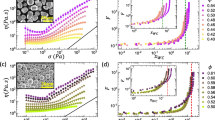Abstract
Experimental evidence suggests that anisotropic stress induces alignment of intracellular actin filaments. We develop a model for this phenomenon, which includes a parameter reflecting the sensitivity of the microfilament network to changes in the stress field. When applied to a uniform cell sheet at rest, the model predicts that for sufficiently large values of the sensitivity parameter, all the actin filaments will spontaneously align in a single direction. Stress alignment can also be caused by a change in external conditions, and as an example of this we apply our model to the initial response of embryonic epidermis to wounding. Our solutions in this case are able to reflect the actin cable that has been found at the wound edge in recent experiments; the cable consists of microfilaments aligned with stress at the wound boundary of the epithelium. These applications suggest that stress-induced alignment of actin filaments could play a key role in some biological systems. This is the first attempt to include the alignment phenomenon in a mechanical model of cytogel.
Similar content being viewed by others
Literature
Chen, W. 1981. Mechanism of retraction of the trailing edge during fibroblast movement.J. Cell Biol. 90, 187–200.
Clark, R. A. F. 1989. Wound repair.Curr. Op. Cell Biol. 1, 1000–1008.
Franke, R. P., M. Grafe, H. Schnittler, D. Seiffge, C. Mittermayer and D. Drenckhahn. 1984. Induction of human vascular endothelial stress fibres by fluid shear stress.Nature 307, 648–649.
Gerhart, J. and R. Keller. 1986. Region-specific cell activities in amphibian gastrulation.Ann. Rev. Cell Biol. 2, 201–229.
Harris, A. K. 1982. Traction and its relations to contraction in tissue cell locomotion. InCell Behaviour, R. Bellairs, A. Curtis and G. Dunn (Eds), pp. 109–134. Cambridge: Cambridge University Press.
hergott, G. J., M. Sandig and V. I. Kalnins. 1989. Cytoskeletal organisation of migrating retinal pigment epithelial cells during wound healing in organ culture.Cell Motil. 13, 83–93.
Kolega, J. 1986. Effects of mechanical tension on protrusive activity and microfilament and intermediate filament organization in an epidermal epithelium moving in culture.J. Cell Biol. 102, 1400–1411.
Ludueña, M. A. and N. K. Wessells. 1973. Cell locomotion, nerve elongation and microfilaments.Dev. Biol. 30, 427–440.
Martin, P. and J. Lewis. 1991. The mechanics of embryonic skin wound healing—limb bud lesions in mouse and chick embryos. InFetal Wound Healing: a Paradigm of Tissue Repair, N. S. Adzick and M. T. Longaker (Eds), pp. 265–279. New York: Elsevier.
Martin, P. and J. Lewis. 1992. Embryonic wound healing actin cables and epidermal movement. Submitted.
Murray, J. D., G. F. Oster and A. K. Harris. 1983. A mechanical model for mesenchymal morphogenesis.J. math. Biol. 17, 125–129.
Murray, J. D. and G. F. Oster. 1984a. Generation of biological pattern and form.IMA J. Math. appl. med. Biol. 1, 51–75.
Murray, J. D. and G. F. Oster. 1984b. Cell traction models for generating pattern and form in morphogenesis.J. math. Biol. 19, 265–279.
Murray, J. D., P. K. Maini and R. T. Tranquillo. 1988. Mechanochemical models for generating biological pattern and form in development.Phys. Rep. 171, 59–84.
Odell, G. M., G. Oster, P. Alberch and B. Burnside. 1981. The mechanical basis of morphogenesis.Dev. Biol. 85 446–462.
Oster, G. F. 1984. On the crawling of cells.J. Embryol. exp. Morphol. 83 Suppl., 329–364.
Oster, G. F. and G. M. Odell. 1984a. Mechanics of cytogels I: oscillations inPhysarum.Cell Motil. 4, 469–503.
Oster, G. F. and G. M. Odell 1984b. The mechanochemistry of cytogels.Physica D12, 333–350.
Oster, G. F., J. D. Murray and A. K. Harris. 1983. Mechanical aspects of mesenchymal morphogenesis.J. Embryol. exp. Morphol. 78, 83–125.
Oster, G. F., J. D. Murray and G. M. Odell. 1985a. The formation of microvilli. InMolecular Determinants of Animal Form, G. M. Edelman (Ed.), pp. 365–384. New York: Alan R. Liss.
Oster, G. F., J. D. Murray and P. K. Maini. 1985b. A model for chondrogenic condensations in the developing limb: the role of extracellular matrix and cell tractions.J. Embryol. exp. Morphol. 89, 93–112.
Pender, N. and C. A. G. McCulloch. 1991. Quantitation of actin polymerization in two human fibroblast sub-types responding to mechanical stretching.J. Cell Sci. 100, 187–193.
Pereyra, V. 1979.Pasava3: an adaptive finite-difference program for first order nonlinear ordinary boundary problems. InCodes for Boundary Value Problems in Ordinary Differential Equations. B. Childs, M. Scott, J. W. Daniel, E. Denman and P. Nelson (Eds),Lecture Notes in Computer Science, Vol. 76, pp. 67–88.
Pollard, T. D. 1990. Actin.Curr. Op. Cell Biol. 2, 33–40.
Sherratt, J. A. 1992. Actin aggregation and embryonic epidermal wound healing.J. math. Biol., in press.
Sherratt, J. A. and J. D. Murray. 1990. Models of epidermal wound healing.Proc. r. Soc. Lond. B241, 29–36.
Sherratt, J. A. and J. D. Murray. 1991. Mathematical analysis of a basic model for epidermal wound healing.J. math. Biol. 29, 389–404.
Sherratt, J. A. and J. D. Murray. 1992. Epidermal wound healing: a theoretical approach.Comm. theor. Biol., in press.
Spooner, B. S., K. M. Yamada and N. K. Wessells. 1971. Microfilaments and cell locomotion.J. Cell Biol. 49, 595–613.
Stopak, D., N. K. Wessells and A. K. Harris. 1985. Morphogenetic rearrangement of injected collagen in developing chicken limb buds.,Proc. natn. Acad. Sci. U.S.A. 82, 2804–2808.
Valberg, P. A. and D. F. Albertini. 1985. Cytoplasmic motions, rheology, and structure probed by a novel magnetic particle method.J. Cell Biol. 101, 130–140.
Wechezak, A. R., T. N. Wight, R. F. Viggers and L. R. Sauvage. 1989. Endothelial adherence under shear stress is dependent upon microfilament reorganisation.J. cell. Physiol. 139, 136–146.
Winter, G. D. 1962. Formation of the scab and the rate of epithelialization of superficial wounds in the skin of the young domestic pig.Nature 193, 293–294.
Winter, G. D. 1972. Epidermal regeneration studied in the domestic pig. In:Epidermal Wound Healing, H. I. Maibach and D. T. Rovee (Eds), pp. 71–112. Chicago: Year Book Med Publ.
Author information
Authors and Affiliations
Rights and permissions
About this article
Cite this article
Sherratt, J.A., Lewis, J. Stress-induced alignment of actin filaments and the mechanics of cytogel. Bltn Mathcal Biology 55, 637–654 (1993). https://doi.org/10.1007/BF02460654
Received:
Revised:
Issue Date:
DOI: https://doi.org/10.1007/BF02460654




